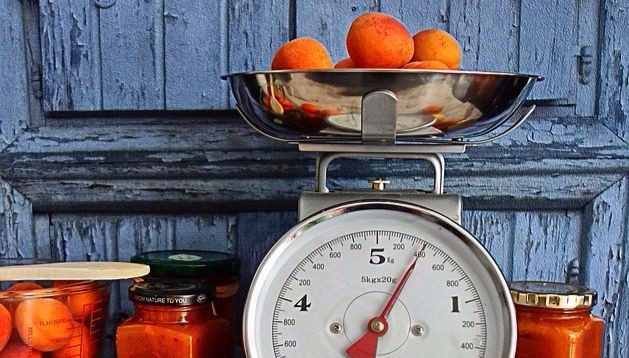Autumn Equinox is the second harvest festival of the three. It says something that three out of eight modern pagan festivals are connected to the harvest. I’ve seen lots of people talking about honoring the harvest in all sorts of symbolic ways: talking about gratitude, letting go of things that need to change or allowing ourselves to focus on the deep and ancestral parts of ourselves and these are all great ideas. What I’d like to talk about is a little more practical and directly connected to the season:
Microharvests.
Even in a modern urban or suburban lifestyle there are a lot of ways that you can directly connect with the process of harvesting. There is nothing like having a huge pile of something you’ve grown to make you feel accomplished. Having worked as a farmer for some years I discovered many powerful spiritual lessons through the process of farm work. Autumn Equinox is a time of balance, but it’s also a time of hard work. Just like the squirrel, we humans have traditionally spent a lot of time preserving food for the lean times.

As modern humans we too can participate in the cycles of harvest directly. One of my most favorite ways to get people involved in microharvesting is to introduce them to the smallest of harvests: the bacterial harvest. Traditions from all over the world use bacteria to create some of our most delicious foods, including sauerkraut, cheese, and pickles. In my previous post about spirit exorcism I talk about how important it is to create spiritual ecologies in your home, and how obsessed we are with not interacting with the Other, both in bacterial and spiritual forms. The thing is, research shows that when we live in sterile conditions it causes us to have all sorts of immune system issues. When we kill all bacteria we’re killing the good guys with the bad ones.
Not only do microharvests of this sort connect you to the harvest tide, but they also inoculate your house with good bacteria. Fermenting can create delicious food that has natural probiotics. Eating sauerkraut has the same effect as eating yogurt in terms of keeping your gut healthy. In fact, I would argue that the bacteria are their own powerful spirit/god class. The Norse Kvasir comes to mind as a god of fermentation. We often want our spiritwork to be this vastly remote and supernatural phenomenon, but I find so much health and wellbeing in working with the simple spirits of the land and home. I would encourage you all to try it.
Here’s five ways to incorporate microharvests into your Mabon:
- Lactofermentation. This is preserving process that gives us the deliciousness that is reuben sandwiches, fancy cucumber pickles, and kimchee at your favorite Korean restaurant. It is a bacterial process, primarily through the action of lactobacillus bacteria. That’s where the name lactofermentation comes from. I suggest starting with saurkraut. It’s so easy, and you only need two ingredients, salt and cabbage. Everything else is just window dressing. I’ve got the process memorized at this point, 3 tablespoons of salt to 5 pounds of thinly sliced cabbage. An ecology of bacteria later and then: magically delicious! I suggest reading Katz’s book Wild Fermentation to learn more.
- Sprouts. If you’ve never tried making your own sprouts I suggest it. It’s a fun short term, low investment harvest project. You can get fancy seed sprouting kits or you can just use a mason jar with a paper towel over the top. The important part is to dampen everything evenly, lay the jar on its side, and rotate regularly. Otherwise the dampness will pool in the bottom and you will get sour sprouts, which are not tasty. Your local heath food co-op can hook you up with seeds and a quick search online will show you lots of gadgets if you want to go that route.
- Microgreens. This is slightly more messy and complicated than sprouts, but not by much. You can use sprouting seeds for this or you can buy a fancy pack of seeds specifically for microgreens. It works either way. You can also just pick up a pack of broccoli seeds on sale and that will work great too. Instead of just sprouting the seeds you actually plant them in soil. You harvest them as soon as the first two leaves open up and get green. Those are their cotyledons, or false leaves, carefully created and packed into that seed. You will note they’re a different shape than the rest of the leaves that follow if you don’t harvest them soon enough. Just use scissors to chop them off at the surface of the soil and add them to your hipster harvest! All you need is seeds and a pot for this one. No reading required.
- Sourdough. Real sourdough can be a lifelong friend, because you need a starter. It’s an advanced technique of breadbaking. Basically you have a little bowl of flour and water that is the safe little, snug little, happy little home for your delicious bacterial friends. I know people who have carefully traveled the country with their sourdough pets when they moved, and people who collect different ones like bacterial Pokemon. You don’t have to get that fancy with it. Just put out a bowl of flour and spring water. (You can use tapwater but chlorine kills bacteria and it might not work as well.) Mix and let sit. Mix the next day. Wait till it gets bubbly. Then use! Mix a cup or two into any bread recipe and voila! Sourdough bread. There are lots of great bread books. Two of my favorites are The Laurel’s Kitchen Bread Book and The King Arthur Flour Baker’s Companion.
- Fall gardening. We all think of spring as the time to plant seeds, but the fall is a good time to plant as well. It’s not to late to get one last spinach or lettuce harvest. The limiting factor in growing these simple greens is not usually warmth, but sunlight. I live in in one of the northernmost areas of the United States and I can plant spinach in September and get harvests in November. Farther south there’s more sun and even more of a window of opportunity. Speaking of windows, people who get really into this kind of thing like to make cold frames, little boxes that sit on top of the soil and are topped by a window or clear plastic. If you’re handy there’s lots of plans online for how to build one. The go to book for this is Eliot Coleman’s classic, The Four Season Harvest.
May the blessings of the Autumn tide be upon you and your chosen loved ones, and if you’re so inclined, I would deeply appreciate it if you’d think about becoming a Patreon to support my ongoing attempt to write down all the things!
















